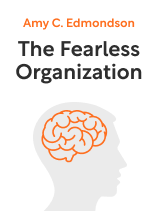

This article is an excerpt from the Shortform book guide to "The Fearless Organization" by Amy C. Edmondson. Shortform has the world's best summaries and analyses of books you should be reading.
Like this article? Sign up for a free trial here.
What is Amy C. Edmondson’s definition of psychological safety? What are the benefits of psychological safety?
According to Amy C. Edmondson, psychological safety in the workplace means workers feel encouraged to speak up and make mistakes without fear of reprisal. Her book The Fearless Organization explains how a psychologically safe work culture is superior to a fear-driven one.
Let’s look at what psychological safety is at work.
The Concept of Psychological Safety
According to Edmondson, psychological safety in the workplace encourages workers to ask questions, share concerns, and risk failure without fear of being judged or experiencing reprisal. She says that psychological safety bolsters factors that drive organizational success including talent, ingenuity, and diverse ideas. When combined with a strong organizational strategy to achieve goals and a motivated, well-trained workforce, psychological safety enables workers and companies to thrive in a sustainable way.
(Shortform note: Change management experts argue that companies in a post-Covid world must take further steps to build trust and ensure that employees are able to do their jobs effectively in the face of rapid changes. One step companies can take is streamlining information so employees aren’t overloaded with things that aren’t relevant to their work. At the same time, companies should provide employees with enough information to avoid creating uncertainty, which can inadvertently foster anxiety among workers who feel left in the dark.)
When workers feel safe to speak up and make mistakes, they can:
- Learn and grow, tap into their creativity, and innovate at their fullest potential
- Ward off avoidable problems by telling their organization about flawed workplace practices and conditions
- Support growth by sharing observations about the market—a critical benefit in an increasingly complex working world defined by the quality, quantity, and accessibility of ideas
(Shortform note: Though the benefits of creating a safe work environment for employees to speak up are clear, experts say there are two distinct obstacles that lead managers to disregard workers’ voices and ideas. First, managers often lack the authority to act on employees’ ideas, so they don’t want to focus on things they can’t change. Second, managers are incentivized to meet short-term target goals and deadlines, making them less inclined to allow themselves to be interrupted by, or to proactively tackle, issues that might interfere with those things.)
Research-Backed Benefits of Psychological Safety
According to Edmondson, decades of research find positive effects of psychological safety on learning, engagement, and performance in the workplace. Research from the 1960s found that people who feel psychologically safe navigate organizational change more effectively than those who don’t, and that psychological safety helps employees overcome defensiveness and anxiety—freeing them to focus on shared goals rather than protecting themselves. Studies in the 1990s found that employees more fully engage at work when they feel comfortable expressing themselves than if they’re worried about having to defend themselves.
In 1999, Edmondson’s dissertation research helped define and provide deeper insight into the role of psychological safety within workplace teams. She found that psychological safety is a feature that manifests in and supports teams’ and groups’ work together and that some team leaders are able to create and foster it, while others aren’t. She concluded that leaders who are able to build psychologically safe environments can improve employee well-being, engagement, and performance; mitigate company risk; and promote high organizational performance across a range of work environments.
The Perils of a Fear-Based Workplace
Edmondson says that despite the clear benefits of psychologically safe workplaces, many companies continue to take a fear-based, command-and-control management approach, a tactic that comes with two key problems.
Problem 1: Fear Leads to Silence, Which Hurts Companies
Edmondson says that in psychologically unsafe work cultures, employees don’t speak up out of fear that they, their ideas, and their concerns will be belittled, disregarded, or lead to retaliation. She says that people’s fear of being judged is so great that they engage in a process of “image management” every day, all day long, in which they monitor and censor what they say to avoid looking silly or stupid in front of others. This strategy keeps them safe so long as they say nothing, but once they open their mouths, people can accuse them of being stupid or incompetent again. Most people can’t handle this, so they stay silent to preserve their image.
Edmondson says there are two big problems with employees’ silence at work:
- They become disengaged and demonstrate low levels of creativity and productivity, which hinders organizations’ ability to innovate, grow, and perform.
- They don’t raise red flags that can help their organization ward off preventable problems and crises.
Problem 2: Fear Creates an Illusion of Success
Edmondson asserts that fear-driven management approaches are popular and can appear to lead to strong outcomes, but their only true accomplishment is creating the illusion of goals being achieved, while companies rot from the inside out.
Further, although intimidation strategies may have worked more successfully in the past, they’re far less effective in today’s knowledge economy. In the past, companies were able to operate with stricter hierarchies and more rigid goals, and many employees operated in a mode of compliance out of fear that they’d get fired if they didn’t meet the mark. This model is less effective in a complex and uncertain knowledge economy, where organizations’ growth and success depend upon the quality, quantity, and accessibility of information available to them—making employees’ voices and ideas more important than ever. Today’s companies must welcome ideas if they hope to tap into the creativity, innovation, and intel required to thrive.
Edmondson acknowledges that there’s no guarantee that replacing a fear-based work culture with a psychologically safe one will result in successful outcomes. To thrive, companies must also have employees with expertise, ingenuity, and the ability to innovate and collaborate effectively. But she maintains that you can’t realize the full potential of these thrive-factors in an environment that’s not psychologically safe. That’s because fear triggers the threat section of your brain, diverting resources away from learning and memory management, thereby limiting your ability to think, collaborate, engage in creative insight, and solve problems.

———End of Preview———
Like what you just read? Read the rest of the world's best book summary and analysis of Amy C. Edmondson's "The Fearless Organization" at Shortform.
Here's what you'll find in our full The Fearless Organization summary:
- The importance of psychological safety in the workplace
- How leaders and non-leaders can foster psychologically safe environments
- Why workers should be able to make mistakes without fear of reprisal






